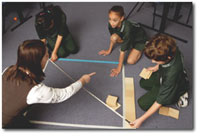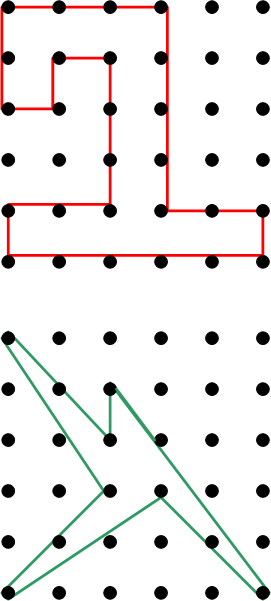Perimeter and area are not the same: 4.0
Supporting Materials
Indicator of Progress

Students recognise that perimeter and area are different measurement attributes, that they are not directly related to each other, and that their calculations and units of measurement are distinct.
Often students learn to calculate perimeter, and then to calculate area. Then when they are asked to calculate both measures on the same object or shape, they confuse the two.
Illustration 1: A simple confusion or something deeper?
|
In this example a student has recorded the value for the area as the value for the perimeter and vice versa. It seems that the student has merely confused the formulas for area and perimeter, but there might be more serious problems. The student may:
|
|
Teaching Strategies
The general teaching challenge here is to ensure that the two concepts are each well developed, and that they are not confused. Students need experiences that illustrate that perimeter and area are only loosely connected attributes of a shape. (Another common confusion is with surface area and volume.)
In such cases, the teaching and learning strategies should be planned to include:
- separate activities for perimeter and area - they must not always be treated together
- activities that contrast the two concepts, such as those below.
Activity 1: Contrasting perimeter and area provides
tasks that prompt students to contrast perimeter and area of rectangles
Activity
2: Area and perimeter of shapes that are not triangles provides
tasks that contrast area and perimeter of composite shapes. It is essential
for students to understand that all two dimensional shapes have perimeter and
area, whether or not students know formulas for the calculations.
|
As with teaching about all measurement attributes, tasks about perimeter and area should include:
|
Activity 1: Contrasting perimeter and area
In order to contrast perimeter and area, it is necessary to calculate the perimeter and area of the same shape. It is important to ask students to calculate a range of one attribute for a given value of the other attribute in some cases. For example, two rectangles can have the same perimeter but different areas, or the same area but different perimeters.
- A string with the ends tied is 6 m long. What are the dimensions of some rectangles that can be marked out using this string? Work out the perimeter and area of each of the rectangles.
Of course, the perimeter of all of the rectangles in 6m. It is the area that varies. This must be emphasised.
- You have a set of 24 square tiles. What might some rectangles that can be made using all those tiles look like? Describe the rectangles as fully as possible.
This is the reverse of the previous activity, in that here it is the area that is fixed and the perimeter that varies. Emphasise this.
- If you have 24m of chicken wire, what might be the dimensions of some rectangular chicken pens that you can make?
Using just whole metre lengths, some rectangles are 3m × 9m (area 27 m2); 4m × 8m (area 32 m2); 5m × 7m (area 35 m2 ); 6m × 6m (area 36 m2). In other words for the same perimeter, the area can vary. It is possible to emphasise this point by asking questions like "What is the smallest area?" or "What is the biggest area?"
It is also important to recognise that not all lengths are whole numbers of metres. At this level, students would use a calculator to find out what happens in between the whole number lengths. It is not the arithmetic that is important here, but observing what happens to area and perimeter.
Activity 2: Area and perimeter of shapes that are not rectangles
We know the area of this room is 20 m. What might be the perimeter?

|
Note that it is intended that students make some assumptions, but there is a need to recognise that the diagram is not drawn to scale unless that is specifically indicated. |
What might be the area of a lawn that is made in this shape?

|
The best way is to estimate the dimensions of the 'cut out' corners and subtract from 15 m2.> Tell students that the diagram is not accurately drawn to scale. It is interesting to observe the perimeters of the possible lawns. Why is the perimeter always 16m? |
Make shapes with small areas on a geoboard.

|
Take a large rubber band and use it to make shapes on a geoboard, aiming for the smallest area for a given perimeter (e.g. in the first diagram, there is a perimeter of 26 and area of 12). Draw the shapes, write down their perimeters and areas, and compare. If shapes such as those in the second diagram are allowed, perimeters and areas can only be estimated. Challenge students to explain why some areas are smaller than others. |
Further Resources
The following resource contains sections that may be useful when designing learning experiences:
Digilearn object *
Geoboard
– students use a virtual geoboard to investigate polygons and other plane
figures including measures of area, perimeter and slope.
(https://www.eduweb.vic.gov.au/dlr/_layouts/dlr/Details.aspx?ID=4058)
* Note that Digilearn is a secure site; DEECD login required.

